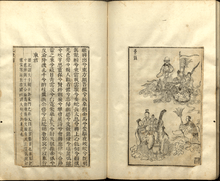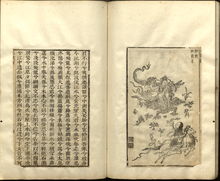Jiu Ge


Jiu Ge, or Nine Songs, (Chinese: 九歌; pinyin: Jiǔ Gē; literally: "Nine Songs") is an ancient set of poems. Together, these poems constitute one of the 17 sections of the poetry anthology which was published under the title of the Chuci (also known as the Songs of Chu or as the Songs of the South). Despite the "Nine", in the title, the number of these poetic pieces actually consists of eleven separate songs, or elegies.[1] This set of verses seems to represent some shamanistic dramatic practices of the Yangzi River valley area (as well as a northern tradition or traditions) involving the invocation of divine beings and seeking their blessings by means of a process of courtship.[2] The poetry consists of lyrics written for performance as part of a religious drama, however the lack of stage directions or indications of who is supposed to be singing at any one time or whether some of the lines represent lines for a chorus makes an accurate reconstruction of how such a shamanic drama would actually have been performed quite uncertain; although, there are internal textual clues, for example indicating the use of spectacular costumes for the performers, and an extensive orchestra.[3]
Authorship and dating
In common with other Chuci works, the authorship of these 11 poems has been attributed to the poet Qu Yuan, who lived over two-thousand years ago. Sinologist David Hawkes finds evidence for this eclectic suite of eleven poems having been written by, "a poet (or poets) at the Chu court in Shou-chun (241-223) B.C."[4]
Text
The "Jiu Ge" songs include eleven (despite the "Nine" in the title). Nine of the verses are addressed to deities, one to the spirits of fallen warriors who died fighting far from home, and the concluding verse.[5] The reason for the discrepancy between the 9 verses referred to in the title and the fact that there are actually 11 is uncertain, although an important question, which has had several possible explanations put forth. Of these explanations, some may be rooted in general Chinese number magic or symbology. More specifically, David Hawkes points out that "nine songs" is referenced in the seminal Chu Ci work, Li Sao, referring to the nine (twice times nine?) dances of Qi of Xia.[6]
Why nine?
Critics and scholars have elaborated various hypotheses as to why the Jiu Ge ("Nine Songs") consists rather of eleven songs. An obvious, and common, suggestion has been that Number 1 and Number 11 songs are somehow to be classified as an introduction and a luan: examination of Song 1 and Song 11 fails to support this convenient conjecture, however.[7] Sinologists Masaru Aoki and David Hawkes propose that for performance purposes there were nine songs/dances performed at each a spring and at an autumn performance, with the spring performance featuring Songs 3 and 5, but not 4 or 6, and the autumnal performance 4 and 6, but not 3 or 5 (with the songs otherwise being performed in numerical order).[8] Another explanation has to do with ancient ideas about numbers and numbering, where by the use of a numeric term, an order of magnitude, estimation, or other symbolic qualities are meant, rather than a specific quanty.[9] 11 songs could be "about 9" songs.
List of contents
The following table shows the eleven individual poems of the Nine Songs. The English translations are following those of David Hawkes,[10] although he uses Roman numerals for the traditional song order.
| Standard order | English translation | Transcription (based on Pinyin) | Traditional Chinese | Simplified Chinese |
|---|---|---|---|---|
| 1 | The Great Unity, God of the Eastern Sky | "Dong Huang Tai Yi" | 東皇太一 | 东皇太一 |
| 2 | The Lord within the Clouds | "Yun Zhong Jun" | 雲中君 | 云中君 |
| 3 | The God of the Xiang | "Xiang Jun" | 湘君 | 湘君 |
| 4 | The Lady of the Xiang | "Xiang Fu Ren" | 湘夫人 | 湘夫人 |
| 5 | The Greater Master of Fate | "Da Si Ming" | 大司命 | 大司命 |
| 6 | The Lesser Master of Fate | "Shao Si Ming" | 少司命 | 少司命 |
| 7 | The Lord of the East | "Dong Jun" | 東君 | 东君 |
| 8 | The River Earl | "He Bo" | 河伯 | 河伯 |
| 9 | The Mountain Spirit | "Shan Gui" | 山鬼 | 山鬼 |
| 10 | Hymn to the Fallen | "Guo Shang" | 國殤 | 国殇 |
| 11 | Honouring the Dead | "Li Hun" | 禮魂 | 礼魂 |
Illustrated versions
Illustrated versions of the Chuci exist. Below is a selection from the "Nine Songs":
Cast of characters
Of the 11 songs of the "Jiu Ge", 9 are addressed to deities and 1 to the spirits of dead heroes (the last verse section is a conclusional cauda).[11] These deities include He Bo, also known as the River Earl or as the Count of the River, and the Lord (or God) of the Clouds.
Shaman
The shamanic voice is an important part of the proceedings here.
Dong Huang/Jun / Tai Yi
The character with which Song 1 concerns itself is Taiyi (the Grand Unity) and Lord of the East. This is not a very familiar concept from general Chinese culture and history. However the character of this divinity resolves readily as two familiar parts, here coupled together.
Lord of the East
The Lord of the East is the sun, in its aspect as a deity of the morning.
Taiyi
Taiyi also known as: Tai Yi, Great Unity, and so on, is a familiar deity from the Chinese Daoist/shamanic tradition.
God of Clouds
Back in ancient China, people worshiped the God of Clouds (Yunzhong Jun) hoping that there would be rain and nice weather for crops. This poem can be divided into two parts: one part is sung by the person who does the offering and the other part is sung by the person who acts as the God of Clouds in the form of antiphonal singing in order to show their admiration towards God of Clouds. The God of Clouds is sometimes seen as male and sometimes seen as female, but in Chinese literature, the God of Clouds is usually portrayed as female. This poem expresses the characteristics of the God of Clouds, the deep desire that human have towards God, and how God responds to people’s prayer through the antiphonal singing of human and God. This is such a deep emotion that it cannot even be fully conveyed through this poem.
Xiang River Deities
The deities of the Xiang waters, are the Xiangshuishen. Various conceptions of them exist. Of these conceptions, one set consists of ancient folk belief, and another of more modern interpretation.
He Bo: the River Earl
He Bo has been the deity of the Yellow River, one of the worlds major rivers, and one with close association with Chinese Culture. As such, He Bo has been associated with control of that wild river's occasional devastating floods and general qualities as an agricultural aquifer.
Master of Fate
The Master of Fate is known as Siming (司命) with various English translations (such as, Controller of Fate, Deified Judge of Life, and Director of Destinies). Siming is both an abstract deity (or more rather title thereof) and a celestial asterism. In the Daoist case of the Three Worms, Siming, as Director of Destinies, has the bureaucratic function of human lifespan allocation. As an asterism, or apparent stellar constellation, Siming is associated both with the Wenchang Wang star pattern, near the Big Dipper, in (Aquarius (Chinese astronomy)), and with a supposed celestial bureaucrat official of fate.
Earthly Siming
The earthly Siming has the bureaucratic function of human lifespan allocation.
Astronomical Siming
The astronomical Siming (actually part of asterism 虛, "Emptiness") consists of the Deified Judge of Life star group. Sīmìngyī: (24 Aquarii, 司命一) and Sīmìngèr (26 Aquarii, 司命二).
Shan Gui
Shan Gui is a Mountain Spirit.
Spirits of the Fallen and the Dead
Presupposing some sort of continuation of life after death: ghosts or spirits.
Translations
The first translation of the Nine Songs into a European language was done by the Viennese scholar August Pfizmaier (1808-1887).[12] Over 100 years later Arthur Waley (1889-1966) accredited it as "an extremely good piece of work, if one considers the time when it was made and the meagreness of the material to which Pfizmaier had access."[13]
See also
- Chinese_theology#Taiyi
- Chu ci
- He Bo
- List of Chuci contents
- Liu An
- Liu Xiang (scholar)
- Qu Yuan
- Simians (Chinese poetry)
- Song Yu
- Wang Yi (librarian)
- Xiang River goddesses
- Yunzhongzi
Notes
- ↑ Murck, 11
- ↑ Davis, xlvii
- ↑ Hawkes, 95-96
- ↑ Hawkes, 98
- ↑ Hawkes, 95
- ↑ Hawkes, 97
- ↑ Hawkes, 99
- ↑ Hawkes, 99-100
- ↑ Hawkes, 101
- ↑ Hawkes, 101-118
- ↑ Hawkes, 95
- ↑ Waley, 15: August Pfizmaier: Das Li-sao und die Neun Gesdnge. In Denkschriften der Phil. Hist. Classe der Kaiserl. Akad. d. Wissen- schaften, Vienna, 1852.
- ↑ Ibid., 18
References
- Davis, A. R. (Albert Richard), Editor and Introduction,(1970), The Penguin Book of Chinese Verse. (Baltimore: Penguin Books).
- Hawkes, David, translator and introduction (2011 [1985]). Qu Yuan et al., The Songs of the South: An Ancient Chinese Anthology of Poems by Qu Yuan and Other Poets. London: Penguin Books. ISBN 978-0-14-044375-2
- Murck, Alfreda (2000). Poetry and Painting in Song China: The Subtle Art of Dissent. Cambridge (Massachusetts) and London: Harvard University Asia Center for the Harvard-Yenching Institute. ISBN 0-674-00782-4.
- Waley, Arthur, tr. 1955. The Nine Songs. Allen and Unwin.
| Chinese Wikisource has original text related to this article: |
